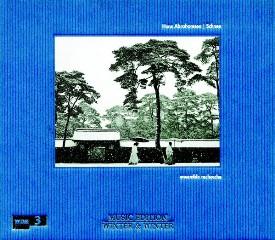Hans Abrahamsen - Schnee: Ten Canons For Nine Instruments (2009)
Hans Abrahamsen - Schnee: Ten Canons For Nine Instruments (2009)

1 Canon 1A: Ruhig Aber Beweglich 8:43 2 Canon 1B: Fast Immer Zart Und Still 9:12 3 Canon 2A: Lustig Spielend, Aber Nicht Zu Lustig, Immer Ein Bißchen Melancholisch 6:57 4 Intermezzo 1 2:01 5 Canon 2B: Lustig Spielend, Aber Nicht Zu Lustig, Immer Ein Bißchen Melancholisch 7:24 6 Canon 3A: Sehr Langsam, Schleppend Und Mit Trübsinn (Im Tempo Des "Tai Chi") 6:53 7 Canon 3B: Sehr Langsam, Schleppend Und Mit Trübsinn (Im Tempo Des "Tai Chi") 7:20 8 Intermezzo 2 1:57 9 Canon 4A (Minore) (Hommage À WAM): Stürmisch, Unruhig Und Nervös 2:34 10 Canon 4B (Maggiore) (Hommage À WAM): Sehr Stürmisch, Unruhig Und Nervös 2:38 11 Intermezzo 3 0:41 12 Canon 5A (Rectus): Einfach Und Kindlich 1:07 13 Canon 5B (Inversus): Einfach Und Kindlich 1:15 ensemble recherche: Melise Mellinger - Violin Barbara Maurer - Viola Åsa Åkerberg - Cello Martin Fahlenbock - Flute Jaime Gonzalez - Oboe Shizuyo Oka - Clarinet Christian Dierstein - Drums Klaus Steffes-Holländer - Piano Jean-Pierre Collot - Piano
Winter & Winter's Hans Abrahamsen: Schnee features an extended chamber work by one of Denmark's most intriguing contemporary composers, Hans Abrahamsen, whose compact, transparent yet dense music has won him many followers and kind critical notices throughout Europe. Abrahamsen is viewed as a composer whose work moves against the precepts of the Darmstadt style that emerged in the 1950s, and his name is sometimes included with that of other Danish composers identified with the "New Simplicity" movement that began in the 1960s. However, in Denmark, "New Simplicity" sought to decrease subjectivity in favor of an even more objective style than that of Darmstadt by using simpler, less obviously angular musical materials than their German and Italian colleagues.
Abrahamsen's language is extremely compressed, and like Anton Webern, his worklist is generally made up of very short pieces, his Piano Concerto (2000) lasts only a little over 15 minutes. This selection from Abrahamsen's Schnee (2006-2008) lasts just short of an hour and employs the strategy of building one large piece out of small movements. There are actually 13 movements in Schnee, as five canons are halved into "A" and "B" realizations and three Intermezzos are also included. It was commissioned by ensemble recherche for the Wittener Tage für Neue Kammermusik and broadcast over the WDR, who made the master tapes of these performances. The sound is terrific, the performances are obviously studied and fully coherent, and the music just isn't very interesting. According to Abrahamsen, all of the movements are developed from canonic processes and were inspired by Johann Sebastian Bach's deep investment in such techniques. While some pieces have a spooky effectiveness -- certainly too subjective an effect to coordinate with Abrahamsen's stated preference toward objectivity -- those that do tend to be wispy in texture and a little too long in the tooth; those that don't are flittery, inarticulate sounding, and needlessly repetitive. Least satisfying, the canonic procedures used to make the music are apparently invisible, which may be Abrahamsen's intent, though given his thorough grounding in Bach -- where the canons are plainly visible -- one does not assume that this was the case; although Webern wrote in a significantly different idiom from Bach, the canons used in his music are also clear and apparent. If one is already well predisposed to the music of Abrahamsen, Winter & Winter's Schnee might still be a good bet. But it is likely not the place to start with this composer and one wonders where this odd statement fits within Abrahamsen's grand scheme of things. ---Uncle Dave Lewis, AllMusic Review
download (mp3 @320 kbs):
yandex mediafire uloz.to cloud.mail.ru gett








